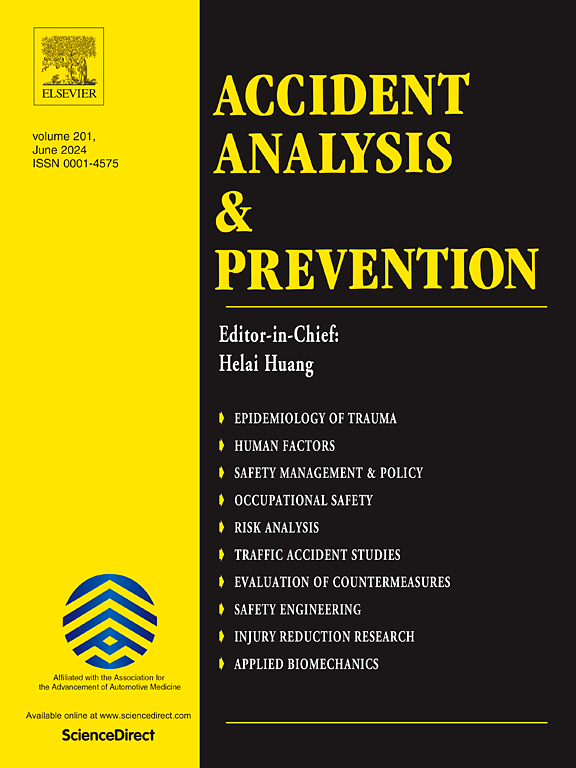Validation of human benchmark models for automated driving system approval: How competent and careful are they really?
IF 5.7
1区 工程技术
Q1 ERGONOMICS
引用次数: 0
Abstract
Over the last few decades, new technological solutions have enabled the fast development of Advanced Driver Assistance Systems (ADAS) and Automated Driving Systems (ADS). These systems are expected to improve comfort, productivity and, most importantly, safety for all road users. To ensure that the systems are safe, rules and regulations describing the systems’ approval and validation procedures are in effect in Europe. The UNECE Regulation 157 (R157) is one of those. Annex 3 of R157 describes two driver models, representing the performance of a “competent and careful” driver, which can be used as benchmarks to determine whether, in certain situations, a crash would be preventable by a human driver. However, these models have not been validated against human behavior in real safety–critical events. Therefore, this study uses counterfactual simulation to assess the performance of the two models when applied to 38 safety–critical cut-in near-crashes from the SHRP2 naturalistic driving study. The results show that the two computational models performed rather differently from the human drivers: one model showed a generally delayed braking reaction compared to the human drivers, causing crashes in three of the original near-crashes. The other model demonstrated, in general, brake onsets substantially earlier than the human drivers, possibly being overly sensitive to lateral perturbations. That is, the first model does not seem to behave as the competent and careful driver it is supposed to represent, while the second seems to be overly careful. Overall, our results show that, if models are to be included in regulations, they need to be substantially improved. We argue that achieving this will require better validation across the scenario types that the models are intended to cover (e.g., cut-in conflicts), a process which should include applying the models counterfactually to near-crashes and validating them against several different safety related metrics. Possible improvements to the models include adding components that better reflect the level of urgency of the traffic situation, something which is lacking in the current models.
自动驾驶系统审批的人类基准模型验证:它们到底有多称职和谨慎?
在过去的几十年里,新的技术解决方案促进了高级驾驶辅助系统(ADAS)和自动驾驶系统(ADS)的快速发展。这些系统有望提高所有道路使用者的舒适度、生产力,最重要的是提高安全性。为了确保系统是安全的,描述系统批准和验证程序的规则和法规在欧洲生效。欧洲经委会条例157 (R157)就是其中之一。R157的附件3描述了两种驾驶员模型,代表了“有能力和谨慎”驾驶员的表现,这可以作为基准来确定在某些情况下,人类驾驶员是否可以预防碰撞。然而,这些模型尚未在真实的安全关键事件中针对人类行为进行验证。因此,本研究使用反事实模拟来评估这两种模型在SHRP2自然驾驶研究中应用于38个安全关键切入事故时的性能。结果显示,这两种计算模型的表现与人类驾驶员截然不同:与人类驾驶员相比,其中一种模型显示出普遍延迟的制动反应,导致了三起最初的险些撞车事故。另一个模型显示,一般来说,刹车启动比人类司机早得多,可能对横向扰动过于敏感。也就是说,第一个模型似乎没有表现出它应该代表的称职和谨慎的驾驶员,而第二个模型似乎过于谨慎。总的来说,我们的结果表明,如果要将模型纳入法规,则需要对其进行实质性改进。我们认为,要实现这一点,需要对模型所要涵盖的场景类型(例如,切入冲突)进行更好的验证,这个过程应该包括将模型反事实地应用于接近碰撞的情况,并根据几个不同的安全相关指标对它们进行验证。这些模型可能的改进包括增加能够更好地反映交通状况紧急程度的组件,这是当前模型所缺乏的。
本文章由计算机程序翻译,如有差异,请以英文原文为准。
求助全文
约1分钟内获得全文
求助全文
来源期刊

Accident; analysis and prevention
Multiple-
CiteScore
11.90
自引率
16.90%
发文量
264
审稿时长
48 days
期刊介绍:
Accident Analysis & Prevention provides wide coverage of the general areas relating to accidental injury and damage, including the pre-injury and immediate post-injury phases. Published papers deal with medical, legal, economic, educational, behavioral, theoretical or empirical aspects of transportation accidents, as well as with accidents at other sites. Selected topics within the scope of the Journal may include: studies of human, environmental and vehicular factors influencing the occurrence, type and severity of accidents and injury; the design, implementation and evaluation of countermeasures; biomechanics of impact and human tolerance limits to injury; modelling and statistical analysis of accident data; policy, planning and decision-making in safety.
 求助内容:
求助内容: 应助结果提醒方式:
应助结果提醒方式:


